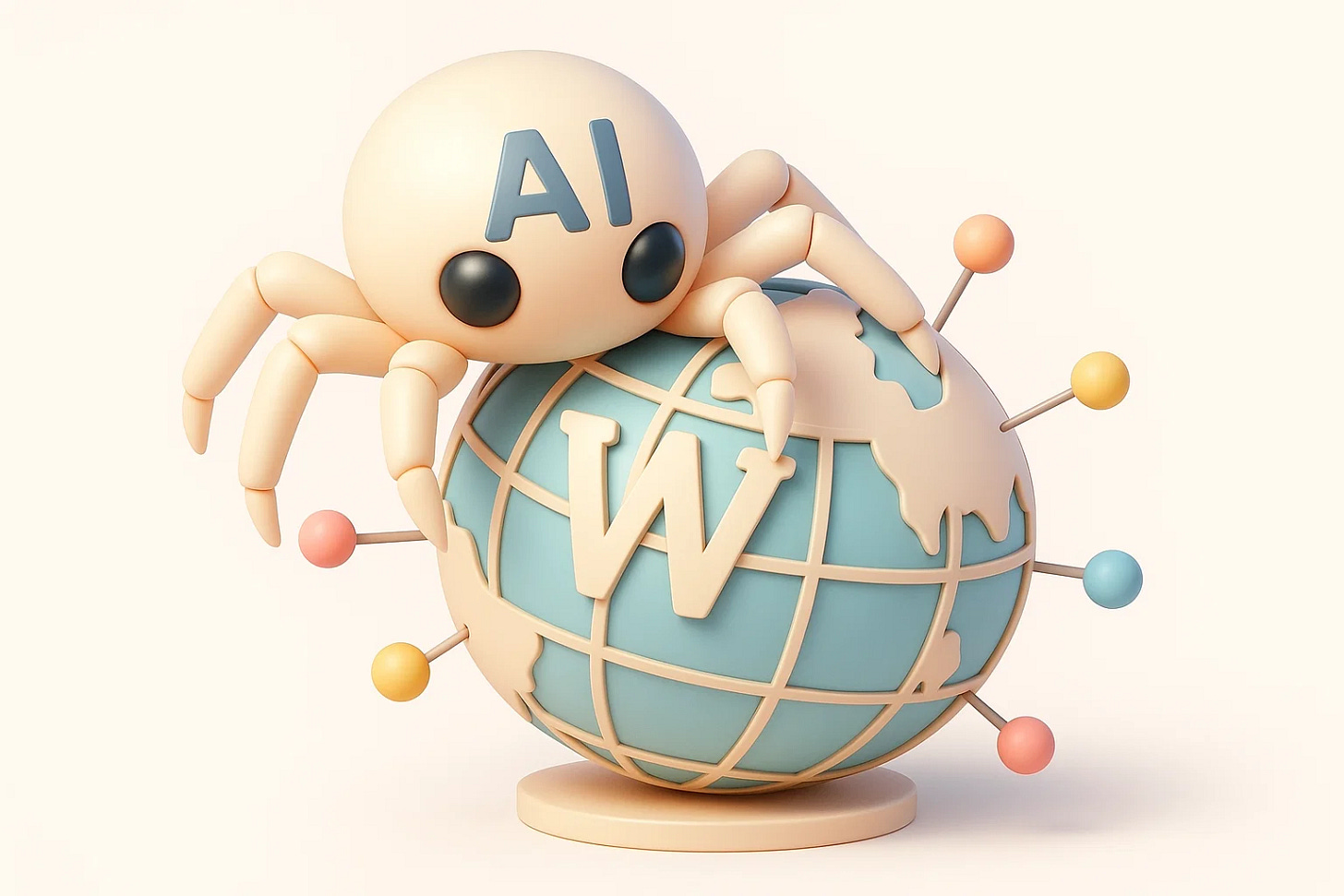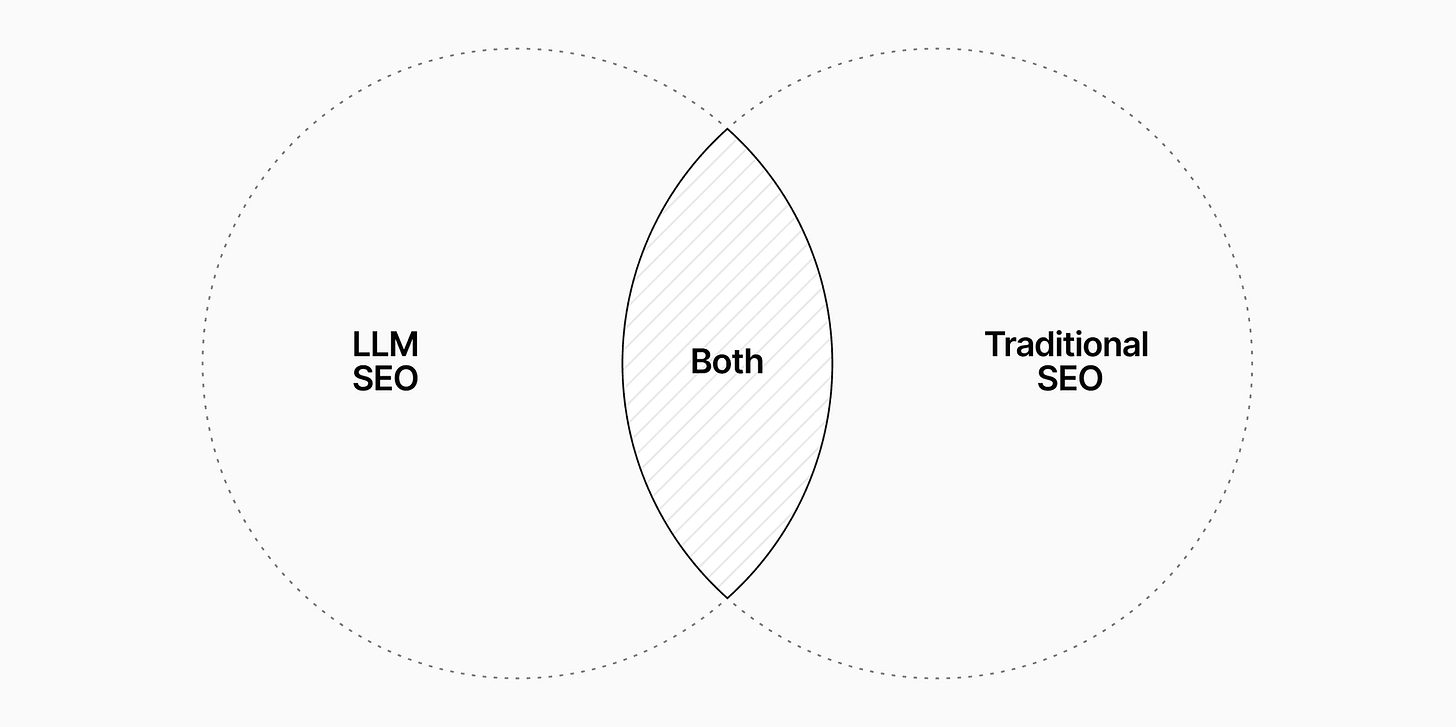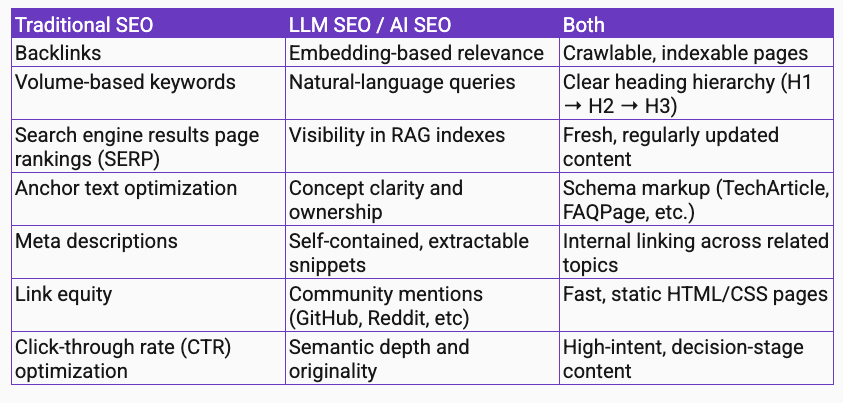The Zero-Click Internet: Adapting SEO for AI Search & LLMs
Why traditional SEO isn't enough in the age of AI, and how to future-proof your online presence.
The Zero-Click Internet
The digital landscape is undergoing a seismic shift. Traditional search engines, once the primary gateway to online content, are now sharing the stage with AI-powered tools like ChatGPT, Claude, Perplexity, and Google's AI Overviews. These platforms don't list links — they generate answers, synthesize information, and, increasingly, determine how users discover and engage with content.
The “Zero-Click Internet” is a new catchphrase coined to represent how more and more search results today are AI generated summaries, where users no longer need to scroll down to several “blue links” and find the one that is most relevant.
Google used to send one visitor for 2 sites indexed 10yrs ago. The rate Google crawls at hasn’t changed and yet, six months ago it was 6 scrapes for 1 visitor. And it has accelerated, now it is 15 scrapes for 1 visitor … If you look at OpenAI, six months ago it was 250 scrapes for 1 visitor, now it is 1500 scapes for 1 visitor.
— Matthew Prince, CEO of Cloudflare, interviewed on CNBC shares data on traffic from Google and OpenAI (ChatGPT) to websites.
Consumers are moving away from scrolling multiple websites, opting instead for the immediate gratification of a summary. “Zero-clicking” on blue links is here to stay.
For businesses and content creators, this evolution poses a critical question: Is your website optimized for AI-driven search?
The New SEO Reality
Search is no longer just about keywords, SERPs, and backlinks.
AI-first summaries are changing what gets surfaced and how it gets summarized. Your website’s role has shifted from being a destination to being a source of authority in a generated answer.
That demands a different mindset: You’re not just writing for people or for search crawlers. You’re now writing for language models that summarize your business to both.
AI Search demands a different mindset — You’re now writing for language models that summarize your business to both users and search crawlers.
What’s Changing — Backed by the Numbers
Research by Adobe Analytics has shown a 1300% increase in AI search referral traffic to retail sites in 2024 compared to the prior year (Adobe)
Here’s what makes this shift urgent:
Search behavior is migrating fast: Over 51% of U.S. Gen Z and Millennial users now use AI tools like ChatGPT for search-like tasks at least weekly (GWI, 2024). AI-native search platforms like Perplexity.ai now see over 150M monthly visits, growing 30% MoM (ExplodingTopics 2025).
AI crawlers are everywhere: GPTBot (OpenAI), CCBot (Common Crawl), and Anthropic’s Claude browsing agent are indexing vast portions of the web. If your site blocks them — even unintentionally — you’re missing critical visibility.
Traditional SEO is less defensible: Google’s AI Overviews now show zero-click answers for an increasing share of high-volume queries, with organic clicks dropping 15–25% in some categories (Search Engine Journal, 2024).
Your best content may never get clicked — unless it’s quoted by the AI.How you’re described is now out of your hands — unless you adapt: LLMs don’t rank. They summarize. If your site doesn’t provide clean, clear, structured content the LLM will hallucinate, ignore, or misrepresent it.
Why Traditional SEO Falls Short
While traditional SEO focuses on keywords, backlinks, and metadata to improve rankings on search engine results pages (SERPs), AI-driven search introduces new dynamics:
Contextual Understanding: AI models prioritize context and intent over exact keyword matches.
Content Summarization: Instead of directing users to websites, AI tools often provide synthesized answers, reducing direct traffic.
Dynamic Information Retrieval: AI platforms pull information from various sources, including forums, news sites, and databases, not just high-ranking web pages.
Test AI Visibility
Here are two tests you can do to check your company visibility:
Paste your site into ChatGPT, Claude, or Perplexity and ask:
“Who is this company and what do they offer?”
If it gets it wrong, so will your customers.
Ask an AI search tool:
“What are the top 5 (10) companies in <MY CATEGORY>?”
If you don’t show up, you have a visibility and AI indexing problem.
Why You Might Be Invisible
Even great modern websites can fail LLM SEO readiness. These are a few reasons this happens on a website, as follows:
Blocks GPTBot or CCBot in the
robots.txtfile will prevent your site from being indexed.Relies too heavily on JavaScript or dynamic rendering. This prevents the LLM to index the content for your site.
Uses vague or marketing-heavy homepage copy with no structured summary: Content that does not clearly identify your product value proposition and benefits for an ‘entity’ (e.g. for your ideal customer profile), or does not talk about the problem and solution, will leave LLMs hanging.
Lacks semantic HTML (e.g., misses proper
<h1>usage or schema.org markup) means your site content is not summarized accurately
This means your content may be “readable” by humans — but functionally invisible to AI systems making decisions at scale.
Thinking Forward
Companies realizing this shift are already optimizing their websites to ensure they capture leads and continue growing. The race is fierce — a few months of traffic not hitting your site can add up into six or seven figure in lost revenue.
Cloud platform Vercel used to get 1% of inbound signups from ChatGPT 6 mths ago. In the last month, this number has grown to 10% (Vercel).
Strategies for Optimizing Your Website for AI Search
This is not an “either-or” decision, but an “and” strategy: where you need the site readable by both humans and AI search crawlers used by LLMs. Companies should start by understanding where there are overlaps in SEO strategies that can be leveraged, and where they differ to maximize return on investment.
Comparing the two approaches to SEO is important as we develop a strategy that works for LLMs.
To ensure your content remains visible and authoritative in AI-driven search, consider the following strategies that are more specific for LLM SEO.
1. Cite your Brand in Content
Instead of general first person speak using phrases like “we recommend this”, where “we” is not specified, use your brand, e.g. “GrowthVector research showed that”.
This ensures the LLM recognizes your brand, points of differentiation and strategic recommendations. This is especially important to get cited and stand out from competitors if you have done leading research or want to showcase your product. It helps the LLM associate your brand with your ideas and insights, or product differentiators. Companies can more effectively stand out in their niche when users do an AI search and boost traffic.
2. Update Robot.txt file
The robots.txt file and XML sitemaps need to be updated to ensure that AI crawlers from Google, OpenAI, Anthropic and Perplexity can crawl your site, and it correctly specifies the right pages in your website. If you have rules in the robots.txt file that have not been audited recently, this would be a good place to start to ensure your site is visible.
In your robots.txt files, ensure that you point out which are the important pages to index. There is no point indexing pages such as /admin, /login, or /privacy-policy pages. Instead, ensure that the core content, product, blog and FAQ pages are indexed by the AI search crawler.
3. Implement an LLMs.txt File
As LLMs are limited by context size, they cannot ingest an entire website and answer in-depth ‘word-for-word’ results. Similar to a sitemap for traditional search engines, an llms.txt file guides AI models by providing content in ‘markdown’ format for key pages. This helps AI tools quickly synthesize and retrieve your content for search, optimizing the response to a search query at inference time. (see LLMsTxt.org)
Adoption of this file is at an early stage, but even companies like Anthropic are using it for key pages.
4. Enhance Content Structure and Clarity for LLMs
AI models favor well-structured content with clear headings, bullet points, and concise paragraphs. These can easily be pulled-into LLM databases and produced on search.
For deep articles, ensure the page starts with a concise summary or TL;DR section that can be used directly in search results.
HTML tags should follow a H1 > H2 > H3 hierarchy to break content into logical sections that facilitate better comprehension and retrival.
Label sections appropriately, and
Add lists, bullet points, tables
5. Focus on Entity Optimization
Recent Google Search updates have led to increasing semantic search that aims to find the ‘closeness’ between what users are searching for and related content. This has given rise to increased focus on entity optimization.
Similarly, LLMs are built to synthesize information about an entity and find entities that are closely related, e.g. Lionel Messi ←→ Inter Milan ←→ Argentina, are three entities that are closely related, where as ‘soccer’ is a broad entity with many entities related to it.
An entity is a person, object, place, or any other concept that search engines and LLMs can understand. — SurferSEO
By ensuring your content clearly defines and consistently references key entities related to your brand, such as products, services, and industry terms, aids AI in accurately associating your content with relevant queries. This can be done by using schema.org markup for entities including: FAQ, Business, Person, Article and Video to name a few.
6. Prioritize Authoritative and Comprehensive Content
Develop in-depth content that thoroughly covers topics within your niche. Follow the E-A-T principles (Expertise - Authority - Trust) to continue to stand out by going deep into topics that will give your site higher quality reference links.
AI models seek comprehensive information to generate accurate responses, so being a subject matter authority enhances visibility. If the content can easily be created by an LLM already you haven’t gone deep enough.
In addition to deep-diving into a topic, this can be done by citing academic research, industry reports, author bios and quotes from industry experts in your field. Your content needs to stand out in uniqueness and highlight its perspective.
7. Answer Semantic Queries — How users ask questions
AI search focuses on answering long user queries that are semantically related to content for their authority and clarity. Google also provides a section immediately after a search result called “People Also Ask” (PAA).
By using tools like AnswerThePublic or AlsoAsked, you can discover and answer real user questions. You can also discover questions in discussion and user forum sites such as StackExchange, Reddit, Google Forums and Facebook Groups that are relevant to your niche.
8. Serve Content without Dynamic Javascript Pages
AI crawlers are able to read Javascript on a page, but do not execute the JS to fetch content. Therefore, if your site is built with Javascript that dynamically loads content, it is important to migrate this to Server Side Rendering (SSR), Static Site Generation (SSG) or similar technologies to expose content in plain HTML for browsers.
9. Monitor and Adapt to AI Traffic
Utilize analytics tools including Google Analytics to track traffic originating from AI platforms. Understanding how users interact with your content via AI tools can inform further optimization efforts.
10. Strategic Refresh and Review Cadence
Search will continue to change with LLM updates and increasing adoption by users in different regions and background. Users may have different questions, use different languages, and have different semantic structures (e.g. based on local language structure, terms and colloquialism). This means, your content cannot be the same in each region and needs adaptation. Therefore content refresh is important in line with product launches and local uptake.
Furthermore, as AI crawlers will reindex your content as it updates, it is important to combine your analytics monitoring with your content review to inform your update strategy.
First, ensure your pages have lastmod timestamps to show recency of updates. Then establish a review cadence on 30, 60, 90 days to check what is working vs what has underperformed. Apply the lessons on successful pages to those that are underperforming, by understanding the incoming traffic sources, page structure and content.
Finally, remember to review this against competitors to see what you can do better and stay relevant. You should review both the content and page structure of competitors, as well as traffic to their sites using tools like SimilarWeb.
Conclusion
The integration of AI into search is not a fleeting trend — it's a fundamental transformation of how users access information. By proactively adapting your website to meet the demands of AI-driven search, you position your content for sustained visibility and relevance in an evolving digital ecosystem.
Whether you call it Language Engine Optimization (LEO), Generative Engine Optimization (GEO) or Answer Engine Optimization (AEO) — the AI search driven zero-click transformation is here. Companies that adopt this shift will stay relevant or risk getting left behind.
For a deeper dive into optimizing your website for AI search, consider exploring the following resources:
References
Perplexity Stats, Exploding Topics
Adobe Analytics: Traffic to Retail from AI Sources, Adobe Analytics








